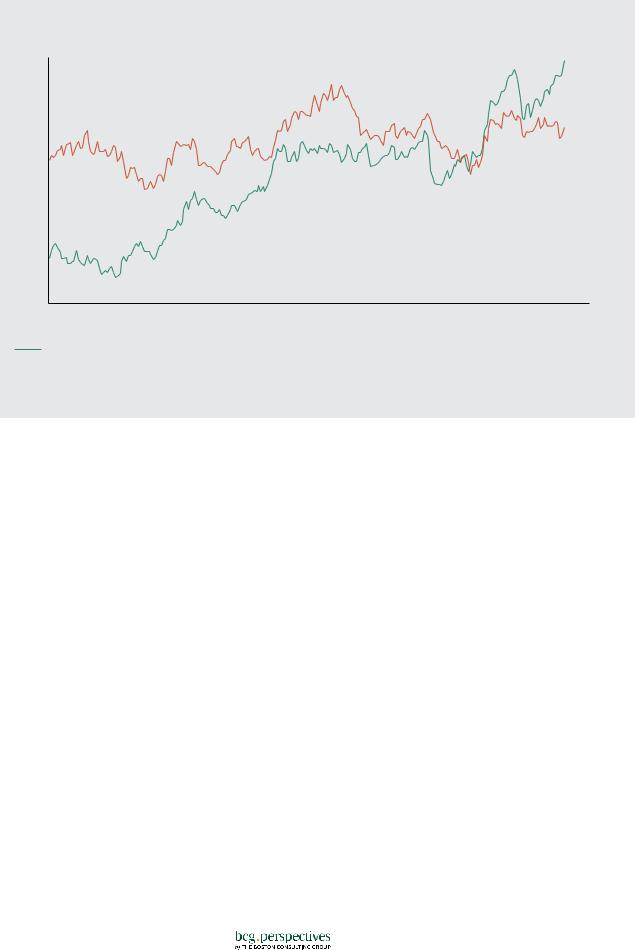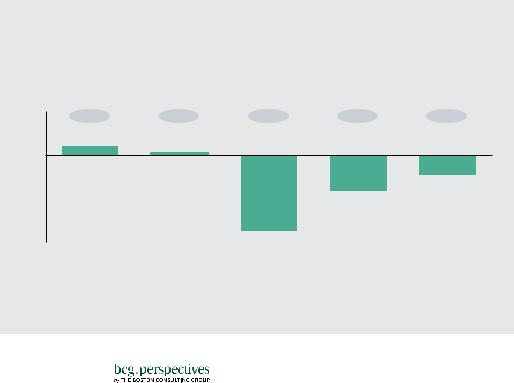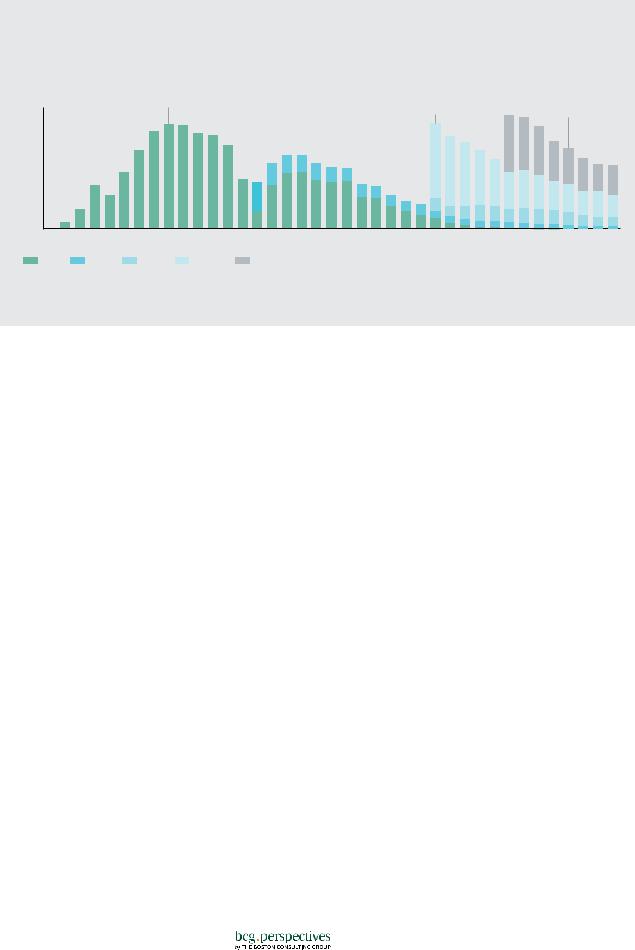
BRENT CRUDE OIL
.pdf
СПБГУАП группа 4736 https://new.guap.ru/i03/contacts
BRENT CRUDE OIL
A BENCHMARK IN DECLINE?
By Iván Martén and Borja Jiménez
Brent crude oil is the primary benchmark for international oil prices
today,serving as the price reference for roughly two-thirds of the world’s traded-oil volume. But despite Brent crude’s current popularity—futures contracts for Brent are the most liquid crude-oil futures con- tracts—there are growing doubts about its suitability as the industry’s major price benchmark. (See Exhibit 1.) Do the market dynamics of Brent crude sufficiently represent those of the world’s oil markets to be the basis for global pricing decisions? And is Brent crude likely to retain its role going forward?
There are a number of factors that raise these questions.The most critical is the fast- er-than-expected decline of oil production in the North Sea,whose aging fields supply the crudes in the blend that constitutes the current Brent benchmark.1 Indeed,the Brent field itself,which was discovered in 1971 and produced approximately half a million barrels of crude a day at its peak, now produces only about a thousand barrels daily.Concerns about the region’s
shrinking output have been exacerbated by the volatility of oil prices and the low oil prices that have prevailed in global oil markets since the middle of 2014; these conditions have reduced regional producers’ incentive to invest in mature fields to enhance production.
There are additional factors that are raising doubts about the security of Brent crude’s status as the global oil-price benchmark, particularly over the medium and longer terms.One is the possibility that the U.S. will lift its current ban on oil exports; lifting the ban would alter global supply-and- demand dynamics,and possibly Brent crude’s relevance,to an extent.Another factor is the ongoing shift in the center of gravity of global oil demand toward non-OPEC countries,especially the ones in Asia.
Questions about whether Brent crude can and should retain its role as the global oilprice benchmark have been surfacing for some time. However, they are being asked today with growing frequency—and for good reason.
For more on this topic, go to bcgperspectives.com

СПБГУАП группа 4736 https://new.guap.ru/i03/contacts
Exhibit 1 | Futures for Brent Crude Are the Most Liquid Crude-Oil Futures Contracts
Open interest (lots, thousands)
2,100 |
|
|
|
|
|
1,800 |
|
|
|
|
|
1,500 |
|
|
|
|
|
1,200 |
|
|
|
|
|
900 |
|
|
|
|
|
600 |
|
|
|
|
|
January 1, 2011 |
January 1, 2012 |
January 1, 2013 |
January 1, 2014 |
January 1, 2015 |
January 1, 2016 |
ICE Brent crude-oil futures contracts |
|
NYMEX WTI crude-oil futures contracts |
|
Sources: Intercontinental Exchange (ICE); U.S. Commodity Futures Trading Commission; Bloomberg.
Note: NYMEX = New York Mercantile Exchange. WTI = West Texas Intermediate. ICE and NYMEX are independent electronic exchanges for the trading of wholesale energy and metals commodities. Brent and West Texas Intermediate futures contracts are traded most heavily globally on the ICE and NYMEX exchanges.
A Benchmark Emerges and Evolves
The current global-pricing system for crude oil came about as a consequence of the 1973 oil shock,which resulted in a significant reduction in OPEC’s influence on global oil prices and,over the following decade, a shrinking share of global oil production for OPEC countries.As growing numbers of non-OPEC countries and producers (including the private companies that substantially developed the North Sea’s oil fields) increased production,demands for pricing transparency and representative standards grew.This led to the development of spot and futures markets in the 1980s in Europe and the U.S.and the adoption of two primary global benchmarks for oil prices, namely Brent crude and West Texas Intermediate (WTI), the primary benchmark for U.S.crude. A new pricing system was born.
Brent crude had,and continues to have,a number of features going for it in terms of its adoption as a global benchmark.One is a sufficiently large volume of production to ensure physical liquidity for the purposes of trading.2 Other features include a repre-
sentative quality standard,which makes the process of pricing other grades easier; the North Sea’s proximity to a major oil-consumption region and the main refining centers of Europe and the U.S.; and, in the UK (whose government oversees the benchmark),stable and supportive tax regulation (from the perspective of producers), a robust legal regime,and relatively low political risk.Brent crude’s status has also been boosted by its diverse ownership of production. Diverse ownership greatly reduces the odds of market interference and price manipulation, compared with a monopolistic structure. This feature has greatly facilitated market participants’ willingness to embrace Brent as a benchmark.
The Brent benchmark has been challenged over the years,however, particularly by WTI, which was the leading global benchmark for a time. In fact, for an extended period, price quotes for WTI and Brent crude moved in parallel, with WTI having a relatively small price premium (about $1.50,on average) from 2000 through 2010. This link was severed in 2011,however, when WTI prices became disconnected
| Brent Crude Oil |
2 |

СПБГУАП группа 4736 https://new.guap.ru/i03/contacts
from prices on international markets, reflecting the effects of the U.S.shale boom and subsequent logistics-driven glut of U.S. supply,coupled with the U.S.government’s ongoing ban on crude exports. In 2011 and 2012,WTI was priced at an average discount of more than $17 per barrel,compared with Brent crude; by mid-November of 2015, that discount had fallen to $4 per barrel. (See Exhibit 2.) The ongoing discount of WTI to Brent has led many to conclude that WTI is a less accurate indicator of global prices than Brent is.
Regarding current concerns about falling North Sea oil production affecting Brent crude’s suitability as the market’s primary benchmark,it is worth noting that falling production has been something that Brent has had to wrestle with for decades.Production from the original Brent oil field started to decline in the mid-1980s,plunging from roughly 400,000 barrels per day in 1986 to about 75,000 barrels in 1990.This led to pricing distortions,with far-reaching effects. To prevent the problem from recurring,oil from other regional fields has been added to the benchmark over time,starting with crude from the Ninian field in 1990 and followed later by oil from the Forties,Oseberg, and Ekofisk fields.Even with this expanded lineup,however,the production of Brent crude has continued to decline,falling from
420,000 barrels per day in 2009 to 260,000 barrels per day in 2014.(See Exhibit 3.)
Can Brent Be Saved in the Short Term by Adding New Crudes?
Some stakeholders have suggested that the best way to address the dwindling production of Brent crude is simply to continue adding other grades from the region.There are factors that complicate this approach, however.The most significant is that oil production on the UK side of the North Sea peaked in 1999,and the chances of discovering new,large fields in the region are relatively small.On a more optimistic note,there has been a major discovery on the Norwegian side of the sea: the Johan Sverdrup field was discovered at the beginning of the decade.But that field,whose output is expected to have a break-even price of about $45 per barrel,is not expected to commence production until the end of 2019.
Other stakeholders have suggested casting a wider net and including oil from other parts of the world in the blend.Two grades that have been discussed as potential candidates are grades from the Russian Urals and West Africa.Each grade has its advantages but is problematic on some level.Oil from the Urals,were it included in the blend, is sufficient in supply to potentially
Exhibit 2 | The Price Differential Between Brent and West Texas Intermediate Widened Significantly in 2011
WTI’S PRICE PREMIUM OR DISCOUNT RELATIVE TO BRENT CRUDE
$ per barrel
10 |
6% |
1% |
–15% |
–8% |
–7% |
|
|
||||||
0 |
2.0 |
0.7 |
|
|
|
|
|
|
|
|
|||
|
|
|
|
|
||
|
|
|
|
|
–4.0 |
|
–10 |
|
|
|
–8.1 |
|
|
–20 |
|
|
–17.1 |
|
|
|
2000–2005 |
2006–2010 |
2011–2012 |
2013–2014 |
2015 |
||
|
||||||
|
|
|
|
|
(as of mid-November) |
 Price di erential (%)
Price di erential (%)
Source: BCG analysis.
Note: WTI = West Texas Intermediate.
| Brent Crude Oil |
3 |

СПБГУАП группа 4736 https://new.guap.ru/i03/contacts
Exhibit 3 | Production of Brent Crude Has Been Declining Since the Mid-1980s
|
NEW GRADES HAVE BEEN ADDED OVER TIME TO COMPENSATE |
|
||
Barrels per |
1984 |
2002 |
2011 |
|
Oil production from |
Platts adds two new |
Production stops at |
||
day (thousands) |
||||
500 |
the Brent field peaks |
North Sea oil grades |
the first of the Brent |
|
|
to its Brent benchmark |
field’s four platforms |
||
400 |
|
|
|
|
|
|
300 |
|
|
|
|
|
|
200 |
|
|
|
|
|
|
100 |
|
|
|
|
|
|
0 |
1980 |
|
|
1990 |
2000 |
2010 |
|
|
|
||||
Brent |
Ninian |
Forties |
Oseberg |
Ekofisk |
|
|
Source: UK Department of Energy & Climate Change.
Note: Platts is a provider of energy and metals information and an influential source of benchmark price assessments in the physical energy markets.
mitigate concerns about Brent’s shrinking production volume.But inclusion of Urals oil would not significantly increase Brent crude’s market liquidity.Oil from the Urals is also inferior in quality to the grades that compose the current Brent blend—Urals oil is a heavy, sour grade (meaning the sulfur content is relatively high), in contrast to the lighter,sweeter components of the Brent mix.Another factor that argues against the inclusion of oil from the Urals is Russia’s geopolitical environment.
The West African grade, meanwhile, is a sweet crude,hence there are no problems with its quality relative to the Brent blend.3 But the supply of West African oil is prone to frequent disruptions. Further,West African loading schedules are based on fiveweek cycles,while Brent loading schedules are based on twoto three-week cycles.
The addition of other crudes, whether from the North Sea or from other regions,is thus not an easy, single-step solution to the supply challenges,especially the longer-term ones,facing the Brent benchmark.
What the Future Could Hold for Brent
It is hard to predict with confidence what lies ahead for Brent crude’s place as the world’s predominant benchmark for oil
prices.There are a number of possibilities. Within the next five years,it seems possible,if not likely,that other North Sea grades from both the UK and Norwegian sides will be added to the blend in an effort to ward off ongoing concerns about production volume.Potential candidates include Statfjord and Flotta crudes and,ultimately, crude from the Johan Sverdrup field.
A wild card here,however,is the potential for the U.S.to lift its ban on crude oil exports.Were the U.S.to lift its ban,there would be a number of effects on global oil markets.Most significantly,the price differential between WTI and Brent would narrow and aggregate prices of crude oil would likely fall slightly.These effects could weaken the argument for Brent crude as the primary international benchmark and strengthen the argument for WTI,with WTI ultimately regaining its position as the global market’s primary price reference.
In the medium term (that is,within the next ten years), maintaining Brent crude’s status will likely entail adding grades from regions beyond the North Sea.Introducing such crudes, which could include grades of varying qualities,to the Brent blend would demand use of a sulfur de-escalator or a similar system to make the necessary adjustments to the benchmark’s pricing.But this would be manageable,provided there
| Brent Crude Oil |
4 |

СПБГУАП группа 4736 https://new.guap.ru/i03/contacts
is general agreement among market players on the approach used.
In the long term, Brent crude could face a growing challenge to its role from an Asiabased benchmark,given that the global market’s center of gravity is shifting increasingly toward Asia and the region is now the main destination for the world’s incremental oil production. But there are reasons that an Asian benchmark might not supplant Brent. For one, in order for an Asian benchmark to achieve sufficient transparency, multiple regional actors would need to be involved in the benchmark’s price-setting decisions.This could make decision-making cumbersome and ultimately undermine the benchmark’s credibility.Additionally,the Brent Weighted Average is a particularly popular benchmark among Middle Eastern producers currently.These players would likely be reluctant to abandon a standard that they have come to rely on.4
Further,there is already an Asian benchmark in existence—the Asia Petroleum Price Index (APPI),which is commonly used to price crude in countries such as Australia, China,Indonesia, and Malaysia. This would be a logical candidate to replace Brent if an Asian standard were going to do so.But APPI has been largely discounted by Asian players as an accurate predictor of regional oil prices,with most players instead relying on Dated Brent as their preferred benchmark.Hence, an Asian benchmark replacing Brent over the longer term is by no means a sure thing.5
What do we consider most likely to happen? Brent crude’s status as the global oil-price standard is probably secure through the medium term,as there are no obvious candidates to replace it.What hap-
pens beyond then is an open question.It certainly seems plausible that if Brent is ultimately displaced, it will be by an Asian standard,given the region’s growing share of global demand.The adoption of an Asian benchmark presupposes,however, that the benchmark can meet a number of critical criteria,including political stability
among the countries involved in the benchmark’s management, a sufficient volume of production across the component crude grades, and a mix of national oil companies and independent oil companies among the producers of the benchmark’s components that is acceptable to the industry.Satisfying all of the necessary criteria could prove a major challenge.
It is also quite possible that the industry,as it has done in the past,will develop an entirely new pricing scheme over the long term in response to the emergence of game-changing factors,such as geopolitical forces or new types of plays,basins,or tech- nologies—rendering benchmarks such as Brent irrelevant altogether.Time will tell.
Notes
1.Other established oil fields around the world,it should be noted,are also experiencing rapidly declining production; hence,the North Sea’s situation is not unique.
2.See “A Golden Period for Asset-Backed Trading: Time to Reconsider Oil Supply and Marketing,” BCG article,July 2015.
3.In deciding whether a particular grade is suitable for inclusion in the Brent blend,both the supply and the quality of that crude are important.But supply is the more important variable,since a disruption can cause a major problem in the market.Quality issues, in contrast,could be addressed using a sulfur de-escalator,which would adjust the price of Brent crude in response to differentials in quality introduced by its various components.
4.Platts’s Dubai benchmark,a recognized price reference for crude oil delivered to Asian refineries from the Middle East,has traded heavily during the past year,and Platts has updated it recently and is considering the addition of several grades of crude to increase its liquidity.But the benchmark remains far from the point at which it could pose a serious threat to Brent crude’s status as the global oil-price benchmark.
5.Argus Media,a leading provider of price assessments and market data for global energy and commodities markets,and Platts have both stopped using APPI as an index representing oil prices in the Asia-Pacific region.As a result,Indonesian Crude Price,a price index for crude oil from Indonesia, remains as the only regional price marker.
| Brent Crude Oil |
5 |

СПБГУАП группа 4736 https://new.guap.ru/i03/contacts
About the Authors
Iván Martén is a senior partner and managing director of The Boston Consulting Group and the global leader of the Energy practice. You may contact him by e-mail at marten.ivan@bcg.com.
Borja Jiménez is a member of the firm’s Energy practice and manager of the knowledge team’s oil and gas upstream topic. You may contact him by e-mail at jimenez.borja@bcg.com.
Acknowledgments
The authors would like to thank former BCG colleague Jaime Ortiz for his contribution to this article.
This is the sixth in a series of articles exploring issues associated with changing oil prices. The previous articles are “Lower, And More Volatile, Oil Prices: What They Mean and How to Respond” ( January 2015), “Killing the Complexity Monster in E&P: Eight Critical Actions for Upstream Oil and Gas Companies” ( January 2015), “Low Oil Prices Are Challenging Natural-Gas Markets” (March 2015), “Two Sides of the Coin: The Impact of Low Oil Prices on Downstream Oil” ( June 2015), and “A Golden Period for Asset-Backed Trading: Time to Reconsider Oil Supply and Marketing” ( July 2015).
The Boston Consulting Group (BCG) is a global management consulting firm and the world’s leading advisor on business strategy.We partner with clients from the private,public,and not-for-profit sectors in all regions to identify their highest-value opportunities,address their most critical challenges,and transform their enterprises.Our customized approach combines deep insight into the dynamics of companies and markets with close collaboration at all levels of the client organization.This ensures that our clients achieve sustainable competitive advantage,build more capable organizations,and secure lasting results. Founded in 1963,BCG is a private company with 82 offices in 46 countries.For more information,please visit bcg.com.
© The Boston Consulting Group,Inc.2015.
All rights reserved.
9/15 Rev.12/15
| Brent Crude Oil |
6 |
